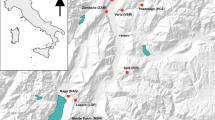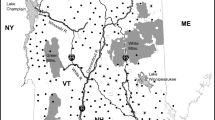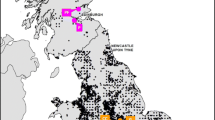Abstract
Reconstruction of a species demographic history can be used to investigate impacts of environmental change through time. Australia’s mesic biome experienced massive changes during the Holocene, including climate fluctuations, increased human populations, and European settlement. Using microsatellite data from 202 brush-tailed rock-wallabies (Petrogale penicillata) sampled across the species current geographic range, we investigated gene flow and inferred the demographic history of the species to explore the historical impacts of environmental change on this once wide-ranging marsupial mammal. We found high levels of genetic diversity in all colonies, despite very restricted contemporary gene flow and no sign of historical gene flow. Demographic analyses showed that individual populations have low effective population sizes (N e < 200). We identified a major historical decline throughout the species range occurring 10,000–1000 years before present, spanning a period with increased El Niño Southern Oscillation activity, increased human population size and establishment of the dingo population. This major decline pre-dates the European settlement of Australia and so places the species most recent dramatic decline into context, suggesting that brushed-tailed rock-wallabies were inherently vulnerable to major changes to their environment.



Similar content being viewed by others
References
Act E (1999) Environment Protection and Biodiversity Conservation Act 1999 (Cth)
Allentoft ME, Heller R, Oskam CL et al (2014) Extinct New Zealand megafauna were not in decline before human colonization. Proc Natl Acad Sci USA 111:4922–4927
Ashcroft MB, Cavanagh M, Eldridge MD, Gollan JR (2014) Testing the ability of topoclimatic grids of extreme temperatures to explain the distribution of the endangered brush-tailed rock-wallaby (Petrogale penicillata). J Biogeogr 41:1402–1413
Attenbrow V (1982) Archaeological Investigation of Deep Creek Shelter, Mangrove Creek Dam. Unpublished report to NSW National Parks and Wildlife Service
Barnosky AD, Koch PL, Feranec RS, Wing SL, Shabel AB (2004) Assessing the causes of late Pleistocene extinctions on the continents. Science 306:70–75
Beerli P (2006) Comparison of Bayesian and maximum-likelihood inference of population genetic parameters. Bioinformatics 22:341–345
Beerli P, Felsenstein J (2001) Maximum likelihood estimation of a migration matrix and effective population sizes in n subpopulations by using a coalescent approach. Proc Natl Acad Sci USA 98:4563–4568
Beerli P, Palczewski M (2010) Unified framework to evaluate panmixia and migration direction among multiple sampling locations. Genetics 185:313–326
Blois JL, McGuire JL, Hadly EA (2010) Small mammal diversity loss in response to late-Pleistocene climatic change. Nature 465:771–774
Both C, Bouwhuis S, Lessells CM, Visser ME (2006) Climate change and population declines in a long-distance migratory bird. Nature 441:81–83
Bradshaw CJA (2012) Little left to lose: deforestation and forest degradation in Australia since European colonization. J Plant Ecol 5:109–120
Brook BW, Sodhi NS, Bradshaw CJA (2008) Synergies among extinction drivers under global change. Trends Ecol Evol 23:453–460
Brooks SP, Gelman A (1998) General methods for monitoring convergence of iterative simulations. J Comput Gr Stat 7:434–455
Brüniche-Olsen A, Jones ME, Austin JJ, Burridge CP, Holland BR (2014) Extensive population decline in the Tasmanian devil predates European settlement and devil facial tumour disease. Biol Lett 10:20140619
Byrne M (2008) Evidence for multiple refugia at different time scales during Pleistocene climatic oscillations in southern Australia inferred from phylogeography. Quatern Sci Rev 27:2576–2585
Chikhi L, Sousa VC, Luisi P, Goossens B, Beaumont MA (2010) The confounding effects of population structure, genetic diversity and the sampling scheme on the detection and quantification of population size changes. Genetics 186:983–995
Colhoun EA, Shimeld PW (2012) Late-Quaternary vegetation history of Tasmania from pollen records. Peopled Landsc 34:29
Cooper A, Turney C, Hughen KA et al (2015) Abrupt warming events drove late pleistocene holarctic megafaunal turnover. Science 349:602–606
Cornuet JM, Luikart G (1996) Description and power analysis of two tests for detecting recent population bottlenecks from allele frequency data. Genetics 144:2001–2014
Cornuet J-M, Pudlo P, Veyssier J et al (2014) DIYABC v2. 0: a software to make approximate Bayesian computation inferences about population history using single nucleotide polymorphism, DNA sequence and microsatellite data. Bioinformatics, 30(8):1187–1189
Crandall KA, Bininda-Emonds ORP, Mace GM, Wayne RK (2000) Considering evolutionary processes in conservation biology. Trends Ecol Evol 15:290–295
Cristescu R, Sherwin W, Handasyde K, Cahill V, Cooper D (2010) Detecting bottlenecks using BOTTLENECK 1.2.02 in wild populations: the importance of the microsatellite structure. Conserv Genet 11:1043–1049
Davis MB, Shaw RG (2001) Range shifts and adaptive responses to quaternary climate change. Science 292:673–679
DECC (2008) Recovery plan for the brush-tailed rock-wallaby (Petrogale penicillata) (ed. Department of Environment and Climate Change S, New South Wales.), Sydney
Diggle PJ, Gratton RJ (1984) Monte Carlo methods of inference for implicit statistical models. J R Stat Soc 193–227
Duncan RP, Blackburn TM, Worthy TH (2002) Prehistoric bird extinctions and human hunting. Proc R Soc Lond B 269:517–521
Eldridge MDB, Close RL (2008) Brush-tailed rock-wallaby Petrogale penicillata. In: The mammals of Australia (Van Dyck S, Strahan R (eds)), pp. 382–384. New Holland, Sydney
Eldridge MDB, Coulson GM (2015) Family Macropodidae (kangaroos and wallabies). In: Handbook of the mammals of the world (Wilson DE, Mittermeier RA (eds)). Lynx Edicions, Barcelona
Eldridge MDB, King JM, Loupis AK et al (1999) Unprecedented low levels of genetic variation and inbreeding depression in an island population of the black-footed rock-wallaby. Conserv Biol 13:531–541
Eldridge MDB, Kinnear JE, Onus ML (2001) Source population of dispersing rock-wallabies (Petrogale lateralis) idengified by assignment tests on multilocus genotypic data. Mol Ecol 10:2867–2876
Ellegren H (2004) Microsatellites: Simple sequences with complex evolution. Nat Rev Genet 5:435–445
Ellegren H, Moore S, Robinson N et al (1997) Microsatellite evolution—A reciprocal study of repeat lengths at homologous loci in cattle and sheep. Mol Biol Evol 14:854–860
Estoup A, Jarne P, Cornuet J (2002) Homoplasy and mutation model at microsatellite loci and their consequences for population genetics analysis. Mol Ecol 11:1591–1604
Excoffier L, Smouse PE, Quattro JM (1992) Analysis of molecular variance inferred from metric distances among DNA haplotypes—application to human mitochondrial-DNA restriction data. Genetics 131:479–491
Frankham R (1995) Effective population size adult population size ratios in wildlife—a review. Genet Res 66:95–107
Frankham R (1998) Inbreeding and extinction: island populations. Conserv Biol 12:665–675
Frankham R (2005) Genetics and extinction. Biol Conserv 126:131–140
Girod C, Vitalis R, Leblois R, Freville H (2011) Inferring population decline and expansion from microsatellite data: a simulation-based evaluation of the MSVAR method. Genetics 88(1):165–179
Gollan K (1984) The Australian dingo: in the shadow of man. Vertebrate Zoogeography Evolu Aust, 921–927
Goossens B, Chikhi L, Ancrenaz M et al (2006) Genetic signature of anthropogenic population collapse in orang-utans. Plos Biology 4:e25
Hansen BD, Harley DKP, Lindenmayer DB, Taylor AC (2009) Population genetic analysis reveals a long-term decline of a threatened endemic Australian marsupial. Mol Ecol 18:3346–3362
Hazlitt S, Goldizen A, Eldridge MB (2006a) Significant patterns of population genetic structure and limited gene flow in a threatened macropodid marsupial despite continuous habitat in southeast Queensland, Australia. Conserv Genet 7:675–689
Hazlitt S, Sigg D, Eldridge M, Goldizen A (2006b) Restricted mating dispersal and strong breeding group structure in a mid-sized marsupial mammal (Petrogale penicillata). Mol Ecol 15:2997–3007
Hazlitt SL, Eldridge MDB, Goldizen AW (2010) Strong matrilineal structuring in the brush-tailed rock-wallaby confirmed by spatial patterns of mitochondrial DNA. Macropods 87–95
Hazlitt SL, Goldizen AW, Nicholls JA, Eldridge MD (2014) Three divergent lineages within an Australian marsupial (Petrogale penicillata) suggest multiple major refugia for mesic taxa in southeast Australia. Ecol Evol 4:1102–1116
Heller R, Lorenzen ED, Okello JBA, Masembe C, Siegismund HR (2008) Mid-Holocene decline in African buffalos inferred from Bayesian coalescent-based analyses of microsatellites and mitochondrial DNA. Mol Ecol 17:4845–4858
Hing S, Narayan E, Thompson RCA, Godfrey S (2014) A review of factors influencing the stress response in Australian marsupials. Conserv Physiol 2:cou027
Holm S (1979) A simple sequentially rejective multiple test procedure. Scand J Stat 6:65–70
Jeffreys H (1998) The theory of probability. Oxford University Press, Oxford
Johnson C (2006) Australia’s mammal extinctions: a 50000 year history. Cambridge University Press, Cambridge
Johnson CN, Letnic M (2013) Introducing a new top predator, the dingo. Invas Biol Ecol Theor 414
Johnson CN, Wroe S (2003) Causes of extinction of vertebrates during the Holocene of mainland Australia: arrival of the dingo, or human impact? Holocene 13:941–948
Kass RE, Raftery AE (1995) Bayes factors. J Am Stat Assoc 90:773–795
Kumar S, Subramanian S (2002) Mutation rates in mammalian genomes. Proc Nat Acad Sci USA 99:803–808
Lennon MJ, Taggart DA, Temple-Smith PD, Eldridge MDB (2011) The impact of isolation and bottlenecks on genetic diversity in the Pearson Island population of the black-footed rock-wallaby (Petrogale lateralis pearsoni; Marsupialia: Macropodidae). Aust Mammal 33:152–161
Letnic M, Dickman CR (2006) Boom means bust: interactions between the El Niño/Southern Oscillation (ENSO), rainfall and the processes threatening mammal species in arid Australia. Biodivers Conserv 15:3847–3880
Lorenzen ED, Nogues-Bravo D, Orlando L et al (2011) Species-specific responses of late quaternary megafauna to climate and humans. Nature 479:359–364
Lourandos H (1997) Continent of hunter-gatherers: new perspectives in Australian prehistory. Cambridge University Press, Cambridge
Lunney D, Law B, Rummery C (1996) Contrast between the visible abundance of the brush-tailed rock-wallaby, Petrogale penicillata, and its rarity in fox and dog scats in the gorges east of Armidale, New South Wales. Wildl Res 23:373–379
Lunney D, Law B, Rummery C (1997) An ecological interpretation of the historical decline of the brush-tailed rock-wallaby P. penicillata in New South Wales. Aust Mammal 19:281–296
Meirmans PG, Van Tienderen PH (2004) GENOTYPE and GENODIVE: two programs for the analysis of genetic diversity of asexual organisms. Mol Ecol Notes 4:792–794
Michalakis Y, Excoffier L (1996) A generic estimation of population subdivision using distances between alleles with special reference for Microsatellite Loci. Genetics 142:1061–1064
Mitchell KJ, Pratt RC, Watson LN et al (2014) Molecular phylogeny, biogeography, and habitat preference evolution of marsupials. Mol Biol Evol 31:2322–2330
Nogués-Bravo D, Rodríguez J, Hortal J, Batra P, Araújo MB (2008) Climate change, humans, and the extinction of the woolly mammoth. Plos Biol 6:e79
O’Connell JF, Allen J (1998) When did humans first arrive in greater Australia and why is it important to know? Evol Anthropol 6, 132–146.
Peery MZ, Kirby R, Reid BN et al (2012) Reliability of genetic bottleneck tests for detecting recent population declines. Mol Ecol 21:3403–3418
Petherick L, Bostock H, Cohen TJ et al (2013) Climatic records over the past 30 ka from temperate Australia—a synthesis from the Oz-INTIMATE workgroup. Quatern Sci Rev 74:58–77
Piggott MP, Banks SC, Stone N, Banffy C, Taylor AC (2006a) Estimating population size of endangered brush-tailed rock-wallaby (Petrogale penicillata) colonies using faecal DNA. Mol Ecol 15:81–91
Piggott MP, Banks SC, Taylor AC (2006b) Population structure of brush-tailed rock-wallaby (Petrogale penicillata) colonies inferred from analysis of faecal DNA. Mol Ecol 15:93–105
Potter S, Cooper SJ, Metcalfe CJ, Taggart DA, Eldridge MD (2012a) Phylogenetic relationships of rock-wallabies, Petrogale (Marsupialia: Macropodidae) and their biogeographic history within Australia. Mol Phylogenet Evol 62:640–652
Potter S, Eldridge MD, Taggart DA, Cooper SJ (2012b) Multiple biogeographical barriers identified across the monsoon tropics of northern Australia: phylogeographic analysis of the brachyotis group of rock-wallabies. Mol Ecol 21:2254–2269
Pritchard JK, Stephens M, Donnelly P (2000) Inference of population structure using multilocus genotype data. Genetics 155:945–959
Rambaut A, Drummond A (2012) Tracer v1. 5.. http://beast.bio.ed.ac.uk/Tracer.
Rasmussen M, Guo X, Wang Y et al (2011) An aboriginal Australian genome reveals separate human dispersals into Asia. Science 334:94–98
Rees ABH, Cwynar LC, Fletcher M-S (2015) Southern westerly winds submit to the enso regime: a multiproxy paleohydrology record from Lake Dobson, Tasmania. Quatern Sci Rev 126:254–263
Rubin DB (1984) Bayesianly justifiable and relevant frequency calculations for the applied statistician. Ann Stat 12:1151–1172
Salmona J, Salamolard M, Fouillot D et al (2012) Signature of a pre-human population decline in the critically endangered Reunion Island endemic forest bird Coracina newtoni. PloS ONE 7:e43524
Sandel B, Arge L, Dalsgaard B et al (2011) The influence of late Quaternary climate-change velocity on species endemism. Science 334:660–664
Short J (1982) Habitat requirements of the brush-tailed rock-wallaby, Petrogale penicillata, in New South Wales. Wildl Res 9:239–246
Short J, Milkovits G (1990) Distribution and status of the brush-tailed rock-wallaby in south-eastern Australia. Wildl Res 17:169–179
Slatkin M (1995) A measure of population subdivision based on microsatellite allele frequencies. Genetics 139:457–462
Smith BJ (2007) BOA: An R package for MCMC output convergence assessment and posterior inference. J Stat Softw 21:1–37
Spencer PBS (1996) Coping with a naturally fragmented environment: a genetic and ecological study of the allied rock-wallaby, Petrogale assimilis. James Cook University of North Queensland, Townsville
Spencer PBS, Odorico DM, Jones SJ, Marsh HD, Miller DJ (1995) Highly variable microsatellites in isolated colonies of the rock-wallaby (Petrogale assimilis). Mol Ecol 4:523–525
Spencer PBS, Adams M, Marsh H, Miller DJ, Eldridge MDB (1997) High levels of genetic variability in an isolated colony of rock-wallabies (Petrogale assimilis): evidence from three classes of molecular markers. Aust J Zool 45:199–210
Stiller M, Baryshnikov G, Bocherens H et al (2010) Withering away—25,000 years of genetic decline preceded cave bear extinction. Mol Biol Evol 27:975–978
Storz JF, Beaumont MA (2002) Testing for genetic evidence of population expansion and contraction: an empirical analysis of microsatellite DNA variation using a hierarchical Bayesian model. Evol Int J org Evol 56:154–166
Taggart D, Menkhorst P, Lunney D (2008) Petrogale penicillata. The IUCN Red List of Threatened Species. http://www.iucnredlist.org
Taylor A, Cooper D (1998) A set of tammar wallaby (Macropus eugenii) microsatellites tested for genetic linkage. Mol Ecol 7:925
Telfer WR, Eldridge MDB (2010) High levels of mitochondrial DNA divergence within short-eared rock-wallaby (Petrogale brachyotis) populations in northern Australia. Aust J Zool 58:104–112
Thuiller W, Broennimann O, Hughes G et al (2006) Vulnerability of African mammals to anthropogenic climate change under conservative land transformation assumptions. Global Change Biol 12:424–440
Van Oosterhout C, Hutchinson WF, Wills DPM, Shipley P (2004) MICRO-CHECKER: software for identifying and correcting genotyping errors in microsatellite data. Mol Ecol Notes 4:535–538
Wakeley J, Aliacar N (2001) Gene genealogies in a metapopulation. Genetics 159:893–905
Walther G-R, Post E, Convey P et al (2002) Ecological responses to recent climate change. Nature 416:389–395
Wilson GA, Rannala B (2003) Bayesian inference of recent migration rates using multilocus genotypes. Genetics 163:1177–1191
Woinarski JCZ, Burbidge AA, Harrison PL (2015) Ongoing unraveling of a continental fauna: Decline and extinction of Australian mammals since European settlement. Proc Nat Acad Sci USA 112:4531–4540
Author information
Authors and Affiliations
Corresponding author
Electronic supplementary material
Below is the link to the electronic supplementary material.
Rights and permissions
About this article
Cite this article
Brüniche-Olsen, A., Hazlitt, S.L. & Eldridge, M.D.B. Genetic evidence of range-wide population declines in an Australian marsupial prior to European settlement. Conserv Genet 18, 1077–1089 (2017). https://doi.org/10.1007/s10592-017-0960-8
Received:
Accepted:
Published:
Issue Date:
DOI: https://doi.org/10.1007/s10592-017-0960-8




